akhtar: Try the following YouTube video link which talks about including various protective devices in an ETAP model. All of the devices listed below require the appropriate data (which may be simple rating data, but may also be far more complex) included as part of the model. I believe that all are available in ETAP, with "blank" templates.
The one-line diagram provided is basically indicating that a 53.7 kVA generator that DOES NOT have the capability of black start (the excitation is fed only from the generator output, not a switchable/optional battery backup) with an output of 11 kV is stepped up to the paired 150 kV transmission busses through a step up transformer. The transformer has both an upstream (generator side) and downstream (utility side) breaker. There is a power take-off from these distribution busses through another breaker to a substation (Cianjur).
It would also appear that there is another "local" 11 kV load somewhere off to the right of what is shown in the OPs print, as designated by the single line heading to the right from the "GCB Cubicle" device grouping.
From the top of the one line, the following devices are included:
Qty 3 SA (
surge arrestors) rated 138 kV, 10 kA
Qty 1 ES (
earthing switch)
Qty 1 DS (
disconnect switch) rated 170 kV, 3150 A
Qty 1 GCB (
gas circuit breaker) rated 170 kV, 3150 A continuous, 40 kA make/break
Qty 2 DS (
disconnect switch) rated 170 kV, 3150 A ... one to each transmission bus
Qty 2 DS (
disconnect switch) rated 170 kV, 1600 A ... one to each transmission bus
Qty 1 GCB (
gas circuit breaker) rated 170 kV, 1600 A continuous, 40 kA make/break
Qty 3 SA (
surge arrestors) rated 138 kV, 10 kA
Qty 1 main transformer rated 53.7 kVA, 150/11 kV, YNd1 with both a fused (72 kV, 10 kA) and switched (72 kV, 600A) connection to neutral
A breaker "cubicle" (labelled incorrectly as a "GCB" cubicle) which contains:
... Qty 1 VCB (
vacuum circuit breaker) rated 17.5 kV, 3150 A continuous, 50 kA make/break
... Qty 2 ES (
earth switch)
An exciter transformer "cubicle" which contains:
... Qty 1 exciter transformer (no rating data or connection)
... Qty 1 rotating rectifier (this is a set of diodes, thyristors, resistors, and control modules mounted directly on the generator)
The generator itself
A neutral grounding "cubicle" which contains:
... Qty 1 NGTR (
neutral grounding transformer) rated 75 kVA, 6.4/0.24 kV
... Qty 1 NGR (
neutral grounding resistor) rated 1 ohm able to carry 241 A for 30 sec
Converting energy to motion for more than half a century


